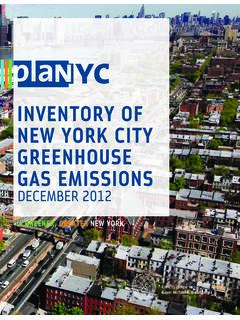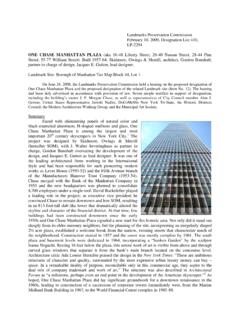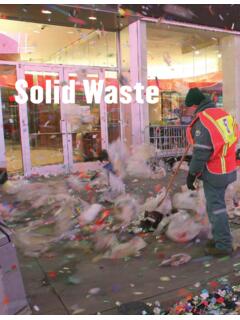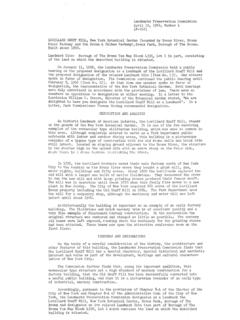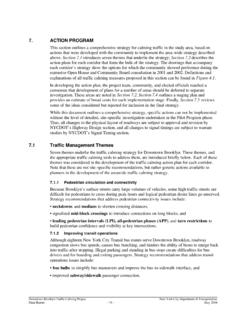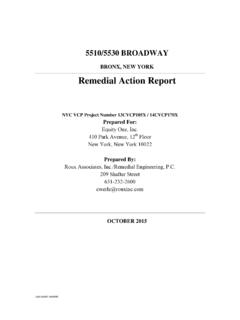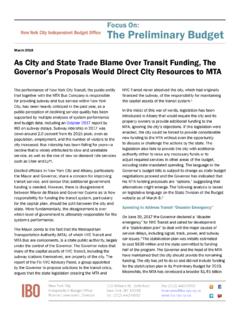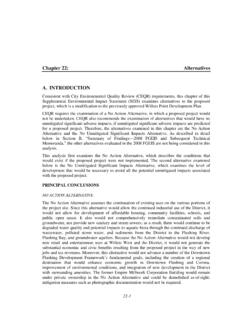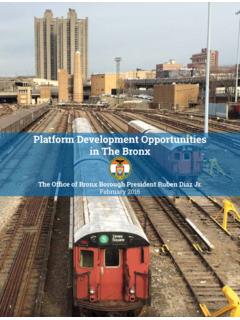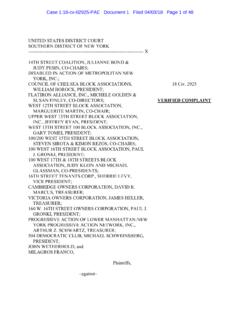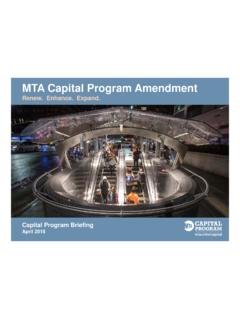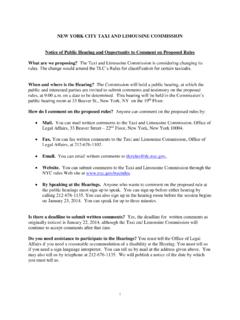Transcription of Transportation - New York City
1 TransportationCredit: AP Worldwide Photos/Henny Ray AbramsTransportationTogether we canImprove and expand sustainable Transportation infrastructure and optionsReduce congestion on our roads, bridges, and at our airportsMaintain and improve the physical condition of our roads and transit system89A GREENER, GREATER NEW york PLANYCK aren Levy // BrooklynPaul Mankiewicz // BronxBrigitte Franco // Staten IslandI live in Tottenville which is the last exit in New york city . Public Transportation is not that great, and I don t know anyone that relies on transport on Staten Island. It may not be the easiest or the best, but driving is really the only way to get around. Whether you take Richmond, Hylan, or Victory Blvd, driving in Staten Island will take you 40 minutes longer than it should. I live 20 minutes, without traffic, from my college but it can take up to an hour with traffic! That s ferry is really a cool part of an urban experience.
2 It slows down life for a few minutes, and it s a cool way to see parts of the city that you might not otherwise see, and pass neighborhoods that you wouldn t otherwise know. It would be awesome if there were a great interconnected system that would let me take ferries around different parts of the city it would give me even more reason not to have to drive my need to be near a subway because I don t drive. The subway is important to me because I do interpreting in the hospital so I have to go to Manhattan and Brooklyn, so I need the subway . I don t want to drive a long way. Walking, biking, driving, or taking one of the best subway and bus systems on the planet, the NYC Transportation network has carried me from Pelham Bay s rocky shores on Long Island Sound to Brighton Beach and the sandy dunes of the Morshed // Queens90 TRANSPORTATIONT ransportation systems shape a city s growth and prosperity.
3 New york city has benefited from billions of dollars of past investments in our bridges, tunnels, roads and subways. Those investments connected New york to the world and channeled development throughout the five boroughs. The shape and reach of our transpor-tation system helped determine how and where we live and work today. To support a vibrant economy now and for the future, we must demonstrate a similar commit-ment and maintain and expand our transpor-tation assets. We must also actively manage our infrastructure to its highest return on investment. Our strategies must focus on our key Transportation needs: handling increased demand from population and job growth; opti-mizing the speed, safety, reliability and comfort across modes; and managing the flow of goods into, out of, and around our city . New york city s Transportation network our roads, bridges, tunnels, subways, commuter rails, buses, taxis, sidewalks, airports, train sta-tions, and ferries moves more people and goods than any other system in the country.
4 The system performs remarkably well, considering the sheer number of people and tons of things being moved and the myriad of federal, regional, state, local, and private sector Transportation agencies and entities involved. But in many ways, we still face significant challenges. Many New Yorkers have long, unreliable, or crowded commutes. Our transit system faces large budget shortfalls. Our ability to add capac-ity is limited. The cost of distributing freight is high compared to other cities. And our passen-ger and freight gateways to the rest of the nation and world are not worthy of a global city . Failing to address these issues imposes a cost on all New Yorkers. The Partnership for New york city estimates that traffic congestion, including reduced productivity, increased shipping times, and pollution-related health problems, costs the New york region more than $13 billion per addition to capacity constraints, our infra-structure is also aging.
5 At a time when transpor-tation investment by state and federal govern-ments is declining, we must find ways to invest in maintenance to keep the network reliable. While we are working with state, federal, and regional agencies for a comprehensive solution, we will continue to take innovative incremental steps to improve the portions of the Transportation net-work directly under the city s jurisdiction. Even in the face of chronic budget shortfalls, we have shown we can find new ways to keep the network reliable and increase the performance of its assets. Through innovative strategies we have strength-ened and expanded Transportation choices throughout the city . We partnered with the Metropolitan Transportation Authority (MTA) to launch the first bus rapid transit lines Select Bus Service (SBS). The city s bike network has nearly doubled. We made it easier and safer to walk with the Safe Routes to Transit, Safe Routes to Schools, and Safe Streets for Seniors programs.
6 Projects like Green Light for Midtown have simplified traffic patterns, improved pedes-trian safety, and created new public plazas throughout the city . To reduce congestion, we installed more than 4,500 Muni-Meters, increasing capacity for curb-side parking. We launched Park Smart, a pilot program that promotes parking turnover in busy commercial areas. The city and the MTA also secured state approval to continue using red light cameras to enforce traffic laws and install cameras on buses to ticket drivers who block dedicated bus used one-time federal stimulus funding stra-tegically to begin 31 major repair projects on our Transportation network, including upgrades to the St. George Ferry Terminal in Staten Island and rehabilitation of the Brooklyn Bridge. Expand sustainable Transportation choices and ensure the reliability and high quality of our Transportation networkTransportation91A GREENER, GREATER NEW york PLANYC15014013012011010090>C9:M199 7199 6199 5199 419 93200220012000199 919 982007200620052004200320092008=dl CZl Ndg`Zgh <Zi id Ldg`Ldg` Vi =dbZ) Di]Zg&( 9g^kZ 6adcZ'( 8 Vgedda* 7jh&' HjWlVn dg GV^agdVY)( TRAFFIC VOLUMETRANSIT RIDERSHIPS ource: NYC Dept.)
7 Of TransportationSource: American Community Survey 2007-2009 New york city Traffic Volumes and Transit RidershipHow New Yorkers Get to WorkWe have also experienced some setbacks. Four years ago, we proposed a plan to reduce traf-fic congestion and provide critical funding for transit to improve bus and subway service. Like the first gasoline tax proposal to pay for roads decades ago, the plan to charge drivers in the Manhattan Central Business District and devote the proceeds to improving Transportation was controversial. The plan s merits were extensively debated, and the projected costs and benefits were broadly evaluated. It would have improved traffic conditions and transit service. While a state commission modified the plan and reached a broad consensus in favor of it, the State Legislature chose not to vote on it. The Legislature did adopt a payroll mobility tax on employers in the region and a taxi surcharge, as well as other motor vehicle related fees.
8 The state plan , which still required transit fare increases, left a large funding gap for system improvements, normal asset replacement, and expansion of transit. Due to the national reces-sion, the payroll tax revenue fell short of fore-cast and resulted in shortfalls that the MTA filled through cost savings, including reductions in bus and subway service. In short, as a result of policy choices compounded by the effects of the national recession, transit service has been reduced, fares have increased, taxes have been levied on employers, and capital maintenance for the future of our transit system is in question. This instability of financial support for New york city s transit system jeopardizes our economy and quality of life. We will continue to work with all of our partners at the regional, state, and fed-eral levels to find ways to reduce congestion and finance our transit network.
9 But we cannot afford to wait for others to act. We will take action in a variety of incremental ways to enhance our Transportation network and mobility options for New Yorkers. Our plan for Transportation : Improve and expand sustainable Transportation infrastructure and options 1 Improve and expand bus service throughout the city 2 Improve and expand subway and commuter rail 3 Expand for-hire vehicle service throughout our neighborhoods 4 Promote car-sharing 5 Expand and improve ferry service 6 Make bicycling safer and more convenient 7 Enhance pedestrian access and safetyReduce congestion on our roads, bridges, and at our airports 8 Pilot technology and pricing-based mechanisms to reduce traffic congestion 9 Modify parking regulations to balance the needs of neighborhoods10 Reduce truck congestion on city streets11 Improve freight movement12 Improve our gateways to the nation and the worldMaintain and improve the physical condition of our roads and transit system13 Seek funding to maintain and improve our mass transit network14 Maintain and improve our roads and bridgesOur PlanWe will continue to expand Transportation options for New Yorkers, and also invest hun-dreds of millions of dollars to maintain the assets they depend on.
10 We will work with the MTA to improve the convenience and speed of our bus network. We will continue to support the mega-projects currently under construction to expand our subway system. To better meet the demand for taxis to underserved areas, we will expand yellow-caliber taxi service throughout the provide growing waterfront communities with Transportation options, we will launch a trial ferry service along the East River. Building on the substantial investments we have made in our bike network, we will work to fill in gaps in our system and connect riders to other modes of transit by installing bike racks near subway stations. And we will continue to make improve-ments to enhance pedestrian reduce congestion on our roads, bridges, and airports we will pilot technology and pricing-based mechanisms. We will modify our park-ing policies to reduce cruising and encourage greater vehicle turnover, using pricing to manage demand for scarce on-street metered parking.
